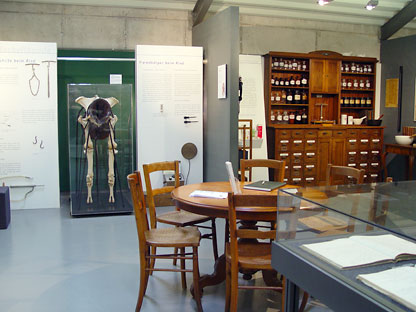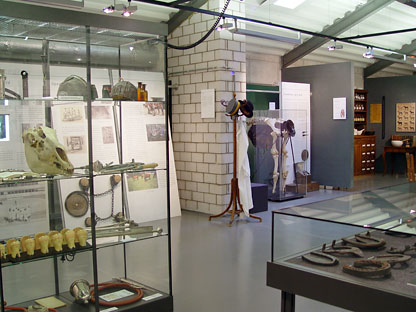Museum of Veterinary History and A. and M. Mahler Microscope Collection Zürich
The museum demonstrates how veterinary medicine has changed from a trade to a scientific profession on the basis of the instruments and documentation from the faculty, as well as through equipment used in practice. The exhibition also provides an entertaining and impressive insight into the history of veterinary medicine at the University of Zurich.

300 years ago: Diseases threaten cattle stocks
Cattle no longer feed as they once did, cows produce less milk, a calf has died...
The farmer has to fend for himself. Can a skilful neighbor, the blacksmith or the knacker come to his aid? There is a famous "cattle doctor" living in the next village. However, his “cures” won't work here either. The vicar is relying upon preaching sermons about "remedies to counter cattle pests".
All efforts are in vain. Cattle plague ravages cowshed after cowshed.
200 years ago: "Veterinary schools" are founded.
- Claude Bourgelat opens the world's first veterinary school in Lyons in 1762.
- The Berne school opens its doors in 1806.
- A veterinary school is established in the "Feldegg" building in Zurich in 1820. Young men train to be vets at this "vocational; school". The veterinary trade gradually becomes a science.
100 years ago: The Faculty of Veterinary Medicine is established.
Following a cantonal referendum, the Faculty of Veterinary Medicine opens as the fifth faculty of the University of Zurich in 1902.
Excellent teachers and researchers consolidate the reputation of the Zurich school. New institutes and clinics are built. The premises in Selnau become tight for space. Following a cantonal referendum, the Veterinary Clinic is built in Winterthurerstrasse in 1959.
The A. and M. Mahler Microscope Collection Zurich
The Microscope Collection houses a vast collection of microscopes from the 18th, 19th and 20th centuries which have also played, and continue to play, an important role in veterinary medicine as instruments of research and diagnosis.
An instrument of research revolutionizes the science
The history of the microscope dates back to the early 17th century. Medical research was slow to embrace the new device at the start. However, with the discovery of body cells, disease-related changes in tissue and micro-organisms, doctors start to conduct microscopic examinations more readily.
Albert Mahler-Lee (1911–2000) used the light microscope all his life and amassed a unique collection of instruments spanning three centuries.
